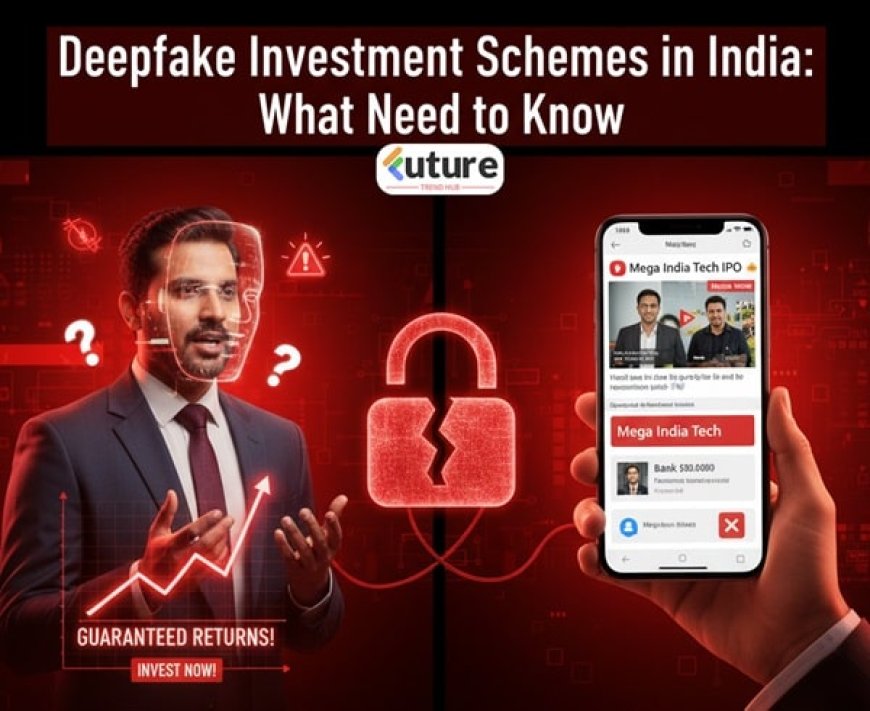Deepfake Investment Schemes in India: What You Need to Know
With rapid advancements in artificial intelligence (AI) and deepfake technology, a concerning trend has emerged: fraudsters using AI-generated videos to impersonate public figures, banks, and government officials to promote investment schemes promising unrealistic returns. These scams are growing in scale and sophistication, targeting ordinary people via social media, WhatsApp, and even direct phone calls.

What Are Deepfake Investment Schemes?
A deepfake investment scheme is one in which an AI-created or AI-manipulated media — video, voice, image — fabricates endorsements or messages by trusted figures (politicians, bankers, corporate leaders). These fake messages claim a person or organization supports or is launching an investment program; they promise very high returns for small investment amounts. Once people engage, ask for payments (sometimes hidden fees, taxes, etc.), or share sensitive data, they may lose everything.
Latest Incidents & Examples in India
Here are some recent, real-world instances showing how deepfake investment fraud is manifesting in India:
-
SBI Warning on Fake AI Investment Videos
The State Bank of India (SBI) issued alerts that deepfake videos are being circulated on social media claiming that SBI, together with the Government of India and multinational companies, is launching an AI-based investment platform offering extremely high returns. SBI clarified it does not endorse any such platform. The Times of India+3The Economic Times+3Business Today+3 -
PIB & False Video of PM Modi
A video went viral saying that Prime Minister Narendra Modi was promoting a scheme where an investment of ₹21,000 would yield over ₹1.25 lakh per day. The Press Information Bureau (PIB) debunked it, confirming it was a deepfake video and had no connection with the PM or government. The Uttam Hindu -
Fake Endorsement by Finance Minister Nirmala Sitharaman
A manipulated video reportedly showing Finance Minister Nirmala Sitharaman endorsing an income-generating investment platform was analysed by the Deepfakes Analysis Unit (DAU), which confirmed that AI-generated audio was used and that the video was manipulated. dau.mcaindia.in -
RBI Cautions on Deepfake Financial Advice
The Reserve Bank of India warned that fake videos involving top officials giving financial or investment advice are being circulated. These often claim launches of schemes or endorsements, which RBI has stated are wholly false. India Today+2Business Today+2 -
Victim Story: Bengaluru, Rs 35-lakhs Loss
A 79-year-old woman in Bengaluru was duped into investing in an AI trading platform after seeing an ad featuring a deepfake of NR Narayana Murthy. The scam unfolded over months: initial small gains, followed by demands for more fees, taxes, etc. Ultimately she lost around ₹34.6 lakh. The Times of India
Why These Scams Work
-
Trust in Public Figures: Impersonating well-known personalities or institutions (banks, ministers) lends false credibility.
-
Sophistication of AI Tools: Deepfakes are getting better — lip sync, voice cloning, facial expressions, even backgrounds.
-
Low Digital Literacy: Especially in semi-urban or rural areas, people may take videos at face value.
-
Greed / “Get-rich-quick” Temptation: Very high promised returns make it hard to resist, especially for those seeking additional income.
-
Viral Social Media / WhatsApp Spread: Sharing of videos before fact checking increases spread.
Red Flags: How to Spot a Fake
Here are signals that a “video claiming to offer investment returns” might be a scam:
| Indicator | What to Look For |
|---|---|
| Unrealistic Returns | Promises like “turn ₹20,000 into ₹1 lakh monthly” are almost always false. |
| Use of Big Names | If a video says a famous person (finance minister, CEO, etc.) backs a scheme — be skeptical. |
| Poor Quality Audio / Video | Slightly off lip sync, unnatural voice, lighting mismatches, odd pauses. |
| Requests for Advance Fees or Taxes | Asking you to pay “processing fees,” “taxes,” or “unlocking fees” before earnings. |
| Links / URLs that are strange | Fake website domains with added words, typos, unfamiliar domain suffixes. |
| Pressure To Act Fast | Scarcity or urgency (“limited seats”, “today only”) is often used to stop people from verifying. |
What Authorities Are Doing & Legal Landscape
-
Public Alerts by SBI, RBI, and government fact-check units (like Press Information Bureau) to warn citizens. Business Today+3The Economic Times+3India Today+3
-
Deepfakes Analysis Units and fact-check platforms are increasingly investigating suspect videos. dau.mcaindia.in+1
-
Regulatory agencies like the major stock exchanges (NSE, BSE) have also cautioned against deepfakes involving CEOs giving financial advice. Reuters+1
-
Law enforcement is beginning to track and file complaints in cyber-crime cells. Victims have approached police (e.g. in Bengaluru case). The Times of India
However, the legal framework is still catching up. Clear laws specific to deepfake misuse are nascent, and enforcement is challenging due to cross-border nature of many of these scams.
Tips to Protect Yourself
-
Verify from Official Sources
Before trusting a video claiming an official endorsement, check the official website or social media account of the person or institution. -
Do Not Click Suspicious Links
If a video or message gives a link to invest, first check the URL; do a web search; don’t download apps or software from unknown sources. -
Check for Media Authenticity
Look for telltale signs of deepfakes: weird or mismatched audio, unnatural facial expressions, lip sync issues, lighting or shadow inconsistencies. -
Be Skeptical of High Return Claims
If it sounds “too good to be true”, it probably is. -
Report Suspect Content
Use fact-check tools, report content to platforms (Facebook, WhatsApp, X/Twitter), inform local police or cybercrime units.
Conclusion
Deepfake investment schemes are more than just rumors — they are real threats causing significant financial losses in India. As AI tools get more powerful, it becomes easier for fraudsters to build convincingly fake content. The only reliable defense is awareness, caution, verification, and reporting.







